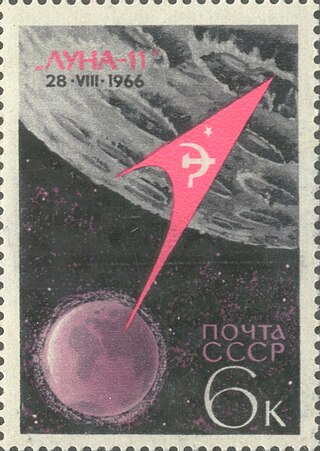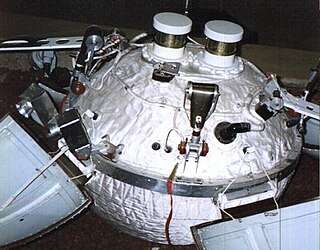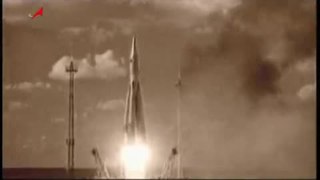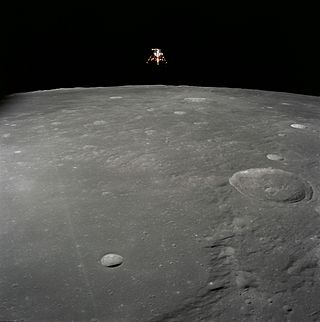
The Surveyor program was a NASA program that, from June 1966 through January 1968, sent seven robotic spacecraft to the surface of the Moon. Its primary goal was to demonstrate the feasibility of soft landings on the Moon. The Surveyor craft were the first American spacecraft to achieve soft landing on an extraterrestrial body. The missions called for the craft to travel directly to the Moon on an impact trajectory, a journey that lasted 63 to 65 hours, and ended with a deceleration of just over three minutes to a soft landing.

Luna 2, originally named the Second Soviet Cosmic Rocket and nicknamed Lunik 2 in contemporaneous media, was the sixth of the Soviet Union's Luna programme spacecraft launched to the Moon, E-1 No.7. It was the first spacecraft to reach the surface of the Moon, and the first human-made object to make contact with another celestial body.

Luna 4, or E-6 No.4, sometimes known in the West as Lunik 4, was a Soviet spacecraft launched as part of the Luna program to attempt the first soft landing on the Moon. Following a successful launch, the spacecraft failed to perform a course correction and as a result it missed the Moon, remaining instead in Earth orbit before possibly transitioning into a solar orbit. Though the mission was unsuccessful, it nevertheless marked a new epoch in the Space Race, which culminated in the successful landing of Luna 9 in 1966.

The Luna programme, occasionally called Lunik by western media, was a series of robotic spacecraft missions sent to the Moon by the Soviet Union between 1959 and 1976. The programme accomplished many firsts in space exploration, including first flyby of the Moon, first impact of the Moon and first photos of the far side of the Moon. Each mission was designed as either an orbiter or lander. They also performed many experiments, studying the Moon's chemical composition, gravity, temperature, and radiation.
Luna 5, or E-6 No.10, was an uncrewed Soviet spacecraft intended to land on the Moon as part of the Luna programme. It was intended to become the first spacecraft to achieve a soft landing on the Moon, however its retrorockets failed, and the spacecraft impacted the lunar surface.

Luna 8, also known as Lunik 8, was a lunar space probe of the Luna program.

Luna 9 (Луна-9), internal designation Ye-6 No.13, was an uncrewed space mission of the Soviet Union's Luna programme. On 3 February 1966, the Luna 9 spacecraft became the first spacecraft to achieve a soft landing on the Moon and return imagery from its surface.

Luna 11 was an uncrewed space mission of the Soviet Union's Luna program. It was also called Lunik 11. Luna 11 was launched towards the Moon onboard a Molniya-M and entered lunar orbit on 27 August 1966.

Luna 13 was an uncrewed space mission of the Luna program by Soviet Union.

Luna 15 was a robotic space mission of the Soviet Luna programme, that was in lunar orbit together with the Apollo 11 Command module Columbia.

Luna 18, part of the Ye-8-5 series, was an uncrewed space mission of the Luna program.

Luna 23 was an uncrewed space mission of the Luna program developed by the Soviet Union.

Luna 24 was a robotic probe of the Soviet Union's Luna programme. The 24th mission of the Luna series of spacecraft, the mission of the Luna 24 probe was the third Soviet mission to return lunar soil samples from the Moon. The probe landed in Mare Crisium. The mission returned 170.1 g (6.00 oz) of lunar samples to the Earth on 22 August 1976.

A lander is a spacecraft that descends towards, then comes to rest on the surface of an astronomical body other than Earth. In contrast to an impact probe, which makes a hard landing that damages or destroys the probe upon reaching the surface, a lander makes a soft landing after which the probe remains functional.

The Soviet space program was the state space program of the Soviet Union, active from 1951 until the dissolution of the Soviet Union in 1991. Contrary to its American, European, and Chinese competitors, which had their programs run under single coordinating agencies, the Soviet space program was divided between several internally competing design bureaus led by Korolev, Kerimov, Keldysh, Yangel, Glushko, Chelomey, Makeyev, Chertok and Reshetnev. Several of these bureaus were subordinated to the Ministry of General Machine-Building. The Soviet space program served as an important marker of claims by the Soviet Union to its superpower status.

A Moon landing or lunar landing is the arrival of a spacecraft on the surface of the Moon, including both crewed and robotic missions. The first human-made object to touch the Moon was Luna 2 in 1959.

A lunar lander or Moon lander is a spacecraft designed to land on the surface of the Moon. As of 2024, the Apollo Lunar Module is the only lunar lander to have ever been used in human spaceflight, completing six lunar landings from 1969 to 1972 during the United States' Apollo Program. Several robotic landers have reached the surface, and some have returned samples to Earth.

The physical exploration of the Moon began when Luna 2, a space probe launched by the Soviet Union, made a deliberate impact on the surface of the Moon on September 14, 1959. Prior to that the only available means of lunar exploration had been observations from Earth. The invention of the optical telescope brought about the first leap in the quality of lunar observations. Galileo Galilei is generally credited as the first person to use a telescope for astronomical purposes, having made his own telescope in 1609, the mountains and craters on the lunar surface were among his first observations using it.
















